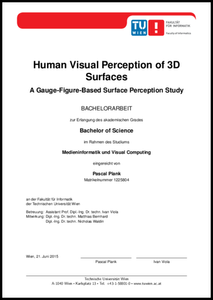Information
- Publication Type: Bachelor Thesis
- Workgroup(s)/Project(s):
- Date: June 2015
- Matrikelnummer: 1225804
- First Supervisor:
- Matthias Bernhard
- Nicholas Waldin
- Ivan Viola
Abstract
The gauge figure task is a methodological tool to study an observer’s perception of surface orientations in renderings and visualization techniques. Originally developed to probe the perception of paintings, i. e. not veridical stimuli, the gauge figure task has since been used to measure absolute perceptual errors by comparing an observer’s surface estimates with the ground truth surface normals.In this bachelor thesis the accuracy of the gauge figure task was investigated, i. e. how well the probed surface estimates align with the perceived surface normals on an absolute scale. To isolate the probing error a user study was carried out using different primitive objects and several depth cues, including depth-from-motion and stereo disparities, to minimize potential perceptual errors. It was expected that a stereoscopic presentation of the gauge figure would reduce the perceptual error of the gauge figure dramatically.
During the experiments I collected about 16.300 probes from 17 participants under different viewing conditions where either the stimuli, the gauge figure, both or none of them were presented in stereo. The results show that the gauge figure estimates for primitive stimuli, e. g. a sphere or a cylinder, align well with the ground truth in modality-consistent conditions, i. e. where stimuli and gauge figure were both presented in stereo or both in mono. In contrast to this, a gauge figure presented in stereo to probe monoscopic stimuli resulted in an enormous slant underestimation. In addition, in the inverse case, where the gauge figure is presented in mono and the stimuli in stereo, an overestimation occurred - even for simple stimulus objects. This bachelor thesis covers the general background and previous work for this subject, the design, setup and procedure of the user study as well as the results and a qualitative assessment. Furthermore, two alternative explanations for the found results are discussed and an outlook for possible future work is given.
Additional Files and Images
Weblinks
No further information available.BibTeX
@bachelorsthesis{Plank_Pascal_2015_HVP,
title = "Human Visual Perception of 3D Surfaces",
author = "Pascal Plank",
year = "2015",
abstract = "The gauge figure task is a methodological tool to study an
observer’s perception of surface orientations in
renderings and visualization techniques. Originally
developed to probe the perception of paintings, i. e. not
veridical stimuli, the gauge figure task has since been used
to measure absolute perceptual errors by comparing an
observer’s surface estimates with the ground truth surface
normals. In this bachelor thesis the accuracy of the gauge
figure task was investigated, i. e. how well the probed
surface estimates align with the perceived surface normals
on an absolute scale. To isolate the probing error a user
study was carried out using different primitive objects and
several depth cues, including depth-from-motion and stereo
disparities, to minimize potential perceptual errors. It was
expected that a stereoscopic presentation of the gauge
figure would reduce the perceptual error of the gauge figure
dramatically. During the experiments I collected about
16.300 probes from 17 participants under different viewing
conditions where either the stimuli, the gauge figure, both
or none of them were presented in stereo. The results show
that the gauge figure estimates for primitive stimuli, e. g.
a sphere or a cylinder, align well with the ground truth in
modality-consistent conditions, i. e. where stimuli and
gauge figure were both presented in stereo or both in mono.
In contrast to this, a gauge figure presented in stereo to
probe monoscopic stimuli resulted in an enormous slant
underestimation. In addition, in the inverse case, where the
gauge figure is presented in mono and the stimuli in stereo,
an overestimation occurred - even for simple stimulus
objects. This bachelor thesis covers the general background
and previous work for this subject, the design, setup and
procedure of the user study as well as the results and a
qualitative assessment. Furthermore, two alternative
explanations for the found results are discussed and an
outlook for possible future work is given.",
month = jun,
address = "Favoritenstrasse 9-11/E193-02, A-1040 Vienna, Austria",
school = "Institute of Computer Graphics and Algorithms, Vienna
University of Technology ",
URL = "https://www.cg.tuwien.ac.at/research/publications/2015/Plank_Pascal_2015_HVP/",
}


